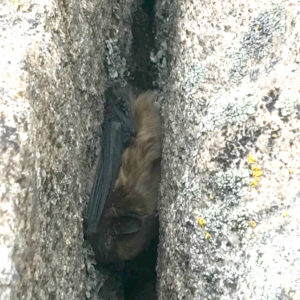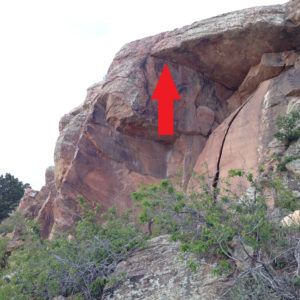
These are hard times for bats in North America. Our winged mammalian cousins face a very serious fungal threat in many parts of the country, which is diminishing their populations by the millions and has the potential to throw entire ecosystems out of balance.
It’s called white-nose syndrome and while it has not yet become an epidemic in Colorado, it has the potential to grow into one, and it has conservation biologists scrambling all over the state trying to study bat populations before it’s too late.

Bats are hard to find in the wilderness, though. Roosting high on cliff faces, deep in cracks and caves up in the mountains, they are often well-hidden from casual observation. And, of course, they’re nocturnal. Gathering data on bat populations in Colorado is not an easy prospect — it’s one that would require a small army of conservation-minded outdoors enthusiasts scouring the state’s high places for tiny, sleeping creatures.
That’s why Rob Schorr started the Climbers for Bat Conservation group out of Colorado State University in 2014. He’s enlisting climbers, boulderers and rock scramblers of all denominations and skill levels to help bat biologists gather data.
“We have such poor information about where they’re roosting in a lot of areas in North America, but particularly in the West,” Schorr says. Scientists need better info and a lot more of it, fast.”
As a zoologist, Schorr studies rare and lesser-known species throughout Colorado. One day, he was browsing the popular climbing site Mountain Project when he stumbled upon an intriguing climb — intriguing not necessarily as a climber, but as a biologist. Out near Carbondale, the climb is called “chiroptophobia” or “the fear of bats,” and is a 5.10, 110-foot trad climb, one that (as the name implies) is full of bats.
“Climbers knew for years that bats would emerge from this rock periodically,” Schorr says. “It was broadly known among climbers, but we as bat biologists had never heard of it.”
It was then that his idea took root — wouldn’t it be nice, Schorr wondered, to put together a group of climbers who could provide information about where they saw bats? A group of climbers for bat conservation, of some kind…
“So, we sat down with a host of climbers, a host of bat biologists and a host of land managers and talked about the opportunity to find out more about where the bats are roosting, and hopefully find populations that would be worthwhile to be monitored,” he says.

The hope is to gather enough data before white-nose syndrome reaches Colorado, and, with luck, how biologists like Schorr can try and mitigate its effects.
The first photo of a bat with white-nose syndrome was taken in Schoharie County New York in 2006. Since then, the disease has killed an estimated 6 million bats throughout the U.S. and Canada and it’s spreading. It’s made it as far west as Missouri and as far south as Mississippi and Georgia. Even here in Boulder, Mallory Cave on Dinosaur Mountain has been indefinitely closed, barricaded with a big, black, wrought-iron gate, in a preemptive measure to protect the bats within, as humans are thought to spread the disease.
Once infected with white-nose syndrome, bats exhibit white fungal growth on their wings and their muzzles. The disease drains their energy, leaving most of them nutrient-depraved and starving. By winter they have no fat stored up for hibernation. It arouses them early and frequently from torpor (bat naps) and can even affect their ability to fly correctly once it starts to damage their wing membranes.
“We know that disease is moving its way west,” Schorr says. “And so [Climbers for Bat Conservation] is our attempt to get more information about where populations might be that we could track in advance of that disease.”
Climbers who want to help need not be bat experts, either. If you want to join the ranks, all you need to do is keep your eyes open while you’re out there climbing. If you see a bat, or discover a population of them on a climb, simply take note, and let Schorr know. Take some pictures if possible, note the direction the climb is facing and the aspect of the climb for bonus points. But really, all Schorr needs to know is where bats roost. Any info beyond that is a bonus.
And, rest assured, climbers, your information will not be used against you. Schorr and his team are not trying to close routes or climbs just because you find bats there. “That is never our intent,” he affirms.
To report bat sightings, visit climbersforbats.colostate.edu or send an email to [email protected].














